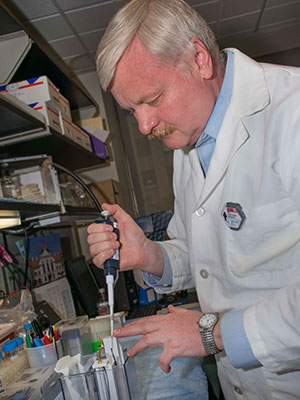Dry AMD: A Decade-Long Pathway to a Promising Therapeutic
For a number of years, Konstantin Petrukhin, PhD, Professor of Ophthalmic Science in the Department of Ophthalmology at NewYork-Presbyterian/
Dr. Konstantin Petrukhin
In patients with dry AMD and Stargardt disease, an inherited juvenile form of macular degeneration, a lipid-containing pigment – lipofuscin – accumulates in the retinal pigment epithelium (RPE), which supports the health of light-sensing photoreceptors. Vision loss results when photoreceptors die, but their death occurs after the loss of RPE cells. Dr. Petrukhin and his Columbia laboratory team postulated that diminishing the harmful results from lipofuscin using RBP4 antagonists might extend RPE and photoreceptor survival.
Bisretinoid A2E, a by-product of the normal visual cycle, is a toxic component of lipofuscin. A2E production is dependent on traffic of retinol from blood to the RPE. Additionally, retinol uptake from blood circulation is dependent on the function of RBP4.
Dr. Petrukhin and his team hypothesized whether reducing the retinoid load of the visual cycle with an RBP4 antagonist might reduce A2E production just enough to avert AMD and Stargardt disease without impeding the necessary biochemical pathway required for vision. “Given the established cytotoxic effects of A2E on RPE and photoreceptors, inhibition of A2E formation could lead to delay in visual loss in patients with dry AMD and Stargardt disease,” says Dr. Petrukhin. “Partial reduction in a visual cycle load with small molecule RBP4 antagonists may reduce the formation of A2E in the retina and prolong RPE and photoreceptor survival in these patients.”
In their investigation, Dr. Petrukhin and his team discovered several new classes of RBP4 antagonists and confirmed in animal models that their use leads to a therapeutic reduction of lipofuscin bisretinoids. These studies eventually yielded LBS-008 (originally known as BPN-14967), the drug candidate that is currently in clinical development.
In mouse studies by Dr. Petrukhin’s lab, LBS-008 reduced levels of RBP4 in the blood by 93 percent after 12 weeks, and A2E levels were reduced by 80 percent in treated mice compared to controls. Dr. Petrukhin notes that other companies have since pursued similar RBP4 antagonist strategies for reducing lipofuscin bisretinoids. “The field has become very crowded, which tells me we made the right choice,” he says.
“I was honored to have led the discovery of LBS-008 in the first and only dry AMD project sponsored by the NIH Blueprint Program, and I am very excited to see LBS-008 entering the next phase of testing.” — Dr. Konstantin Petrukhin
Before proceeding to human trials, Dr. Petrukhin produced preliminary support for the safety, efficacy, and quality of the investigational therapy. “It took a team of experts with a wide range of expertise to advance a candidate drug to clinical trials,” says Dr. Petrukhin, who turned to the National Institutes of Health Blueprint Neurotherapeutics Network for Small Molecules. Launched in 2011, the network provides a structure for researchers who have a promising candidate treatment for an unmet medical need to attract the support of a pharmaceutical company.
A Promising Journey for LBS-008
In 2011, the NIH Blueprint Program selected Dr. Petrukhin’s research to receive funding and the resources to proceed to the development of LBS-008 from early discovery through phase 1a clinical testing. In 2017, a biopharmaceutical company chose LBS-008 for its portfolio to support clinical testing. In June 2020, positive results were reported from two phase 1 clinical trials of LBS-008 in the United States and Australia. A total of 83 subjects received LBS-008 either as a single dose or repeated doses for 14 consecutive days. Both studies concluded that pharmacological doses of LBS-008 were well tolerated and that LBS-008’s pharmacokinetic-pharmacodynamic profile supports daily oral administration. In addition, LBS-008 achieved potentially therapeutic-level target engagement.
In June 2021, a late-stage phase 3 clinical trial of LBS-008 was launched in patients with Stargardt disease and continues to enroll patients. Testing the drug first in Stargardt, a rare disease, allowed LBS-008 to be granted an orphan-drug designation. If LBS-008 is approved for Stargardt disease, it will accelerate the clinical trial process for an indication of atrophic AMD.
"I was honored to have led the discovery of LBS-008 in the first and only dry AMD project sponsored by the NIH Blueprint Program, and I am very excited to see LBS-008 entering the next phase of testing,” says Dr. Petrukhin.
Dr. Petrukhin and his lab team continue to investigate strategies for developing the next generation of RBP4 antagonists, not only as potential therapies for eye diseases, but also as a potential treatment for metabolic diseases such as non-alcoholic fatty liver disease and type 2 diabetes.
Read More
Identification of Transthyretin Tetramer Kinetic Stabilizers That Are Capable of Inhibiting the Retinol-Dependent Retinol Binding Protein 4-Transthyretin Interaction: Potential Novel Therapeutics for Macular Degeneration, Transthyretin Amyloidosis, and Their Common Age-Related Comorbidities. Cioffi CL, Raja A, Muthuraman P, Jayaraman A, Jayakumar S, Varadi A, Racz B, Petrukhin K. Journal of Medicinal Chemistry. 2021 Jul 8;64(13):9010-9041.
Discovery of Bispecific Antagonists of Retinol Binding Protein 4 That Stabilize Transthyretin Tetramers: Scaffolding Hopping, Optimization, and Preclinical Pharmacological Evaluation as a Potential Therapy for Two Common Age-Related Comorbidities. Cioffi CL, Muthuraman P, Raja A, Varadi A, Racz B, Petrukhin K. Journal of Medicinal Chemistry. 2020 Oct 8;63(19):11054-11084.
Design, Synthesis, and Preclinical Efficacy of Novel Nonretinoid Antagonists of Retinol-Binding Protein 4 in the Mouse Model of Hepatic Steatosis. Cioffi CL, Racz B, Varadi A, Freeman EE, Conlon MP, Chen P, Zhu L, Kitchen DB, Barnes KD, Martin WH, Pearson PG, Johnson G, Blaner WS, Petrukhin K. Journal of Medicinal Chemistry. 2019 Jun 13;62(11):5470-5500.
Pharmacological inhibition of lipofuscin accumulation in the retina as a therapeutic strategy for dry AMD treatment. Petrukhin K. Drug Discovery Today: Therapeutic Strategies. 2013;10(1):e11-e20.
For More Information
Dr. Konstantin Petrukhin
Refer a Patient
NewYork-Presbyterian/Columbia - Ophthalmology
NewYork-Presbyterian/Weill Cornell - Ophthalmology
NewYork-Presbyterian
Advances in Ophthalmology
Read more about our latest clinical advances.



